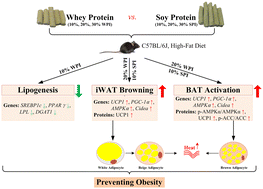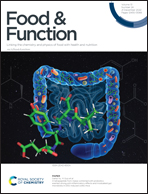Whey protein and soy protein prevent obesity by upregulating uncoupling protein 1 to activate brown adipose tissue and promote white adipose tissue browning in high-fat diet-fed mice†
Abstract
There are inconsistent conclusions regarding the effect of whey protein and soy protein supplementation on obesity, and the underlying mechanisms of a high-protein diet for reducing weight gain remain to be elucidated. The aim of the present study was to investigate the preventive effect of whey protein and soy protein on obesity and its possible mechanism. Eighty-four male C57BL/6J mice were randomly divided into seven dietary groups: control group (10% fat) and 6 groups fed with a high-fat diet (HFD): 10% whey protein isolate (WPI), 20% WPI, 30% WPI, 10% soy protein isolate (SPI), 20% SPI and 30% SPI for 12 weeks. Compared with the 20% SPI group, the 20% WPI group had a significantly lower body weight, serum levels of insulin, total cholesterol and leptin, weight of inguinal white adipose tissue (iWAT), and size of adipocytes in iWAT and epididymal white adipose tissue (eWAT). The body mass index (BMI) and the Lee index were significantly lower in the WPI groups than those in the SPI groups at the same protein level. The body weight, body weight gain and BMI were significantly lower with the decreasing ratio of protein to carbohydrate (P/C). Compared with the 20% SPI group, the expressions of browning-related genes such as UCP1 (uncoupling protein 1), PGC-1α, AMPKα and Cidea and the protein expression of UCP1 were significantly higher in brown adipose tissue (BAT) and iWAT in the 20% WPI group. Moreover, the expressions of lipogenesis-related genes such as SREBP1c, PPARγ, LPL and DGAT1 in BAT, iWAT and eWAT in the 10% WPI group were significantly lower compared with the 10% SPI group. In conclusion, whey protein was more effective than soy protein in preventing obesity in mice, probably by suppressing lipogenesis in adipose tissues, activating BAT and promoting the browning of iWAT. In addition, lowering the P/C ratio was beneficial for combating obesity in the context of a HFD.



 Please wait while we load your content...
Please wait while we load your content...